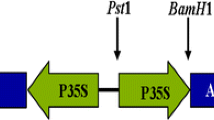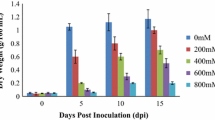Abstract
Key message
A Salicornia europaea L. in vitro cell transformation system was developed and further applied to SeNHX1 function investigation.
Abstract
The exploration of salt-tolerant genes from halophyte has seriously been limited by the lack of self-dependent transformation system. Here, an Agrobacterium tumefaciens-mediated in vitro cell transformation system of euhalophyte Salicornia europaea L. was developed. Calli derived from hypocotyl of S. europaea were co-cultured for 3 days with Agrobacterium at OD600 ranging from 1.0 to 1.5 and then selected with 25 mg/L hygromycin (Hyg). The transformed cells were identified from Hyg positive calli by GUS assay and qRT-PCR, and the transformation efficiency was up to 74.4%. The practicality of this system was further tested via genetic manipulation of S. europaea Na+/H+ antiporter 1 (SeNHX1) gene by creating the overexpressing, silencing, and empty vector cells. Survival ratio and Na+ distribution under salt treatment showed obvious differences in SeNHX1-overexpressing, -silencing, and empty vector cells, indicating the feasibility of this system to analyze gene function. This investigation is enlightening for studies in other non-model plants lacking of self-dependent transformation system.






Similar content being viewed by others
Abbreviations
- FDA:
-
Diacetate
- GUS:
-
β-Glucuronidase
- Hyg:
-
Hygromycin
- Kan:
-
Kanamycin
- LB:
-
Luria–Bertani
- MS:
-
Murashige and Skoog
- NAA:
-
a-Naphthaleneacetic acid
- PI:
-
Propidium iodide
- TDZ:
-
Thidiazuron
- TMT:
-
Ticarcillin
References
Blumwald E (2000) Sodium transport and salt tolerance in plants. Curr Opin Cell Biol 12:431–434
Chen XY, Bao HXGDL, Guo J, Jia WT, Tai F, Nie LL, Jiang P, Feng JJ, Lv SL, Li YX (2014) Na+/H+ exchanger 1 participates in tobacco disease defence against Phytophthora parasitica var. nicotianae by affecting vacuolar pH and priming the antioxidative system. J Exp Bot 65:6107–6122
Chen XY, Bao HXGDL, Guo J, Jia WT, Li YX (2015) Overexpression of SeNHX1 improves both salt tolerance and disease resistance in tobacco. Plant Signal Behav 10:e993240
Dalby DH (1962) Chromosome number, morphology and breeding behavior in the British Salicorniae. British Salicorniae 5:150–162
Davy AJ, Bishop GF, Costa CSB (2001) Salicornia L. (Salicornia pusilla J. Woods, S. ramosissima J. Woods, S. europaea L., S. obscura P.W. Ball and Tutin, S. nitens P.W. Ball & Tutin, S. fragilis P.W. Ball & Tutin and S. dolichostachya Moss). J Ecol 89:681–707
Fan PX, Feng JJ, Jiang P, Chen XY, Bao HXGDL, Nie LL, Jiang D, Lv SL, Kuang TY, Li YX (2011) Coordination of carbon fixation and nitrogen metabolism in Salicornia europaea under salinity: comparative proteomic analysis on chloroplast proteins. Proteomics 11:4346–4367
Fan PX, Nie LL, Jiang P, Feng JJ, Lv SL, Chen XY, Bao HXGDL, Guo J, Tai F, Wang JH, Jia WT, Li YX (2013) Transcriptome analysis of Salicornia europaea under saline conditions revealed the adaptive primary metabolic pathways as early events to facilitate salt adaptation. PLoS One 8:e80595
Feng JJ, Wang JH, Fan PX, Jia WT, Nie LL, Jiang P, Chen XY, Lv SL, Wan LC, Chang S, Li SZ, Li YX (2015) High-throughput deep sequencing reveals that microRNAs play important roles in salt tolerance of euhalophyte Salicornia europaea. BMC Plant Biol 15:63
Gong H, Chen G, Li F, Wang X, Hu Y, Bi Y (2012) Involvement of G6PDH in heat stress tolerance in the calli from Przewalskia tangutica and Nicotiana tabacum. Biol Plantarum 56:422–430
Hasson E, Poljakoff-Mayber A (1995) Callus culture from hypocotyls of Kosteletzkya virginica (L.) seedlings. Plant Cell Tiss Org 43:279–285
Hedenstrom HV, Breckle SW (1974) Obligate halophytes? A test with tissue culture methods. Z Pflanzenphysiol 74:183–185
Hu DG, Li M, Luo H, Dong QL, Yao YX, You CX, Hao YJ (2012) Molecular cloning and functional characterization of MdSOS2 reveals its involvement in salt tolerance in apple callus and Arabidopsis. Plant Cell Rep 31:713–722
Ishimaru K (1999) Transformation of a CAM plant, the facultative halophyte Mesembryanthemum crystallinum by Agrobacterium tumefaciens. Plant Cell Tiss Org 57:61–63
Jefferson RA, Kavanagh TA, Bevan MW (1987) GUS fusion β-glucuronidase as a sensitive and versatile gene fusion marker in higher plants. EMBO J 6:3901–3907
Jones KH, Senft JA (1985) An improved method to determine cells viability by simultaneous staining with fluorescein diacetate propidium iodide. J Histochem Cytochem 33:77–79
Kusvuran S, Ellialtioglu S, Polat Z (2013) Antioxidative enzyme activity, lipid peroxidation, and proline accumulation in the callus tissues of salt and drought tolerant and sensitive pumpkin genotypes under chilling stress. Hortic Environ Biote 54:319–325
Li XG, Gallagher JL (1996) Expression of foreign genes, GUS and hygromycin resistance, in the halophyte Kosteletzkya virginica in response to bombardment with the Particle Inflow Gun. J Exp Bot 47:1437–1447
Lokhande VH, Nikam TD, Ghane SG, Suprasanna P (2010) In vitro culture, plant regeneration and clonal behaviour of Sesuvium portulacastrum (L.) L.: a prospective halophyte. Physiol Mol Biol Plants 16:187–193
Lv SL, Jiang P, Chen XY, Fan PX, Wang XC, Li YX (2012) Multiple compartmentalization of sodium conferred salt tolerance in Salicornia europaea. Plant Physiol Bioch 51:47–52
Ma C, Wang ZQ, Kong BB, Lin TB (2013a) Exogenous trehalose differentially modulate antioxidant defense system in wheat callus during water deficit and subsequent recovery. Plant Growth Regul 70:275–285
Ma JB, Zhang MR, Xiao XL, You JJ, Wang JR, Wang T, Yao YA, Tian CY (2013b) Global transcriptome profiling of Salicornia europaea L. shoots under NaCl treatment. PLoS One 8:e65877
Narasimhulu SB, Deng X, Sarria R, Gelvin SB (1996) Early transcription of Agrobacterium T-DNA genes in tobacco and maize. Plant Cell 8:873–886
Nie LL, Feng JJ, Fan PX, Chen XY, Guo J, Lv SL, Bao HXGDL, Jia WT, Tai F, Jiang P, Wang JH, Li YX (2015) Comparative proteomics of root plasma membrane proteins reveals the involvement of calcium signalling in NaCl-facilitated nitrate uptake in Salicornia europaea. J Exp Bot 66:4497–4510
Noble SM, Davy AJ, Oliver RP (1992) Ribosomal DNA variation and population differentiation in Salicornia L. New Phytol 122:553–565
Park M, Lee H, Lee JS, Byun MO, Kim BG (2009) In planta measurements of Na+ using fluorescent dye CoroNa Green. J Plant Biol 52:298–302
Pfaffl MW (2001) A new mathematical model for relative quantification in real-time RT-PCR. Nucleic Acids Res 29:2002–2007
Rathore MS, Paliwal N, Anand KGV, Agarwal PK (2015) Somatic embryogenesis and in vitro plantlet regeneration in Salicornia brachiata Roxb. Plant Cell Tiss Org 120:355–360
Rozema J, Schat H (2013) Salt tolerance of halophytes, research questions reviewed in the perspective of saline agriculture. Environ Exp Bot 92:83–95
Sedov KA, Fomenkov AA, Solov’yova AI, Nosov AV, Dolgikh YI (2014) The level of genetic variability of cells in prolonged suspension culture of Arabidopsis thaliana. Biology Bulletin 41:493–499
Sharma V, Ramawat KG (2014) Salt stress enhanced antioxidant response in callus of three halophytes (Salsola baryosma, Trianthema triquetra, Zygophyllum simplex) of Thar Desert. Biologia 69:178–185
Shi XL, Han HP, Shi WL, Li YX (2006) NaCl and TDZ are two key factors for the improvement of in vitro regeneration rate of Salicornia europaea L. J Integr Plant Biol 48:1185–1189
Singh A, Jani K, Kumari P, Agarwal PK (2015) Effect of MgCl2 and double concentration of Murashige and Skoog medium on in vitro plantlet and root cultures generation in halophytic grasswort Salicornia brachiata. Plant Cell Tiss Org 120:563–570
Smith MK, McComb JA (1981) Effect of NaCl on the growth of whole plants and their corresponding callus cultures. Aust J Plant Physiol 8:267–275
Sun YL, Hong SK (2012) Agrobacterium tumefaciens-mediated transformation of the halophyte Leymus chinensis (Trin.). Plant Mol Biol Rep 30:1253–1263
Uchida A, Nagamiya K, Takabe T (2003) Transformation of Atriplex gmelini plants from callus lines using Agrobacterium tumefaciens. Plant Cell Tiss Org 75:151–157
Uno Y, Nakao S, Yamai Y, Koyama R, Kanechi M, Inagaki N (2009) Callus formation, plant regeneration, and transient expression in the halophyte sea aster (Aster tripolium L.). Plant Cell Tiss Org 98:303–309
Ushakova SA, Kovaleva NP, Gribovskaya TV, Dolgushev VA, Tikhomirova NA (2005) Effect of NaCl concentration on productivity and mineral composition of Salicornia europaea as a potential crop for utilization NaCl in LSS. Adv Space Res 36:1349–1353
Vancanneyt G, Schmidt R, O’Connor-Sanchez A, Willmitzer L, Rocha-Sosa M (1990) Construction of an intron-containing maker gene: splicing of the intron in transgenic plants and its use in monitoring early events in Agrobacterium-mediated plant transformation. Mol Gen Genet 220:245–250
Vera-Estrella R, Barkla BJ, Bohnert HJ, Pantoja O (1999) Salt stress in Mesembryanthemum crystallinu L. cell suspensions activates adaptive mechanisms similar to those observed in the whole plant. Planta 207:426–435
Wang XC, Fan PX, Song HM, Chen XY, Li XF, Li YX (2009) Comparative proteomic analysis of differentially expressed proteins in shoots of Salicornia europaea under different salinity. J Proteome Res 8:3331–3345
Wilson GH, Grolig F, Kosegarten H (1998) Differential pH restoration after ammonia-elicited vacuolar alkalisation in rice and maize root hairs as measured by fluorescence ratio. Planta 206:154–161
Wu GX, Wang G, Ji J, Li Y, Gao HL, Wu J, Guan WZ (2015) A chimeric vacuolar Na+/H+ antiporter gene evolved by DNA family shuffling confers increased salt tolerance in yeast. J Biotechnol 203:1–8
Yang X, Ji J, Wang G, Yang SH, Zhao Q, Josine TL (2011) Over-expressing Salicornia europaea (SeNHX1) gene in tobacco improves tolerance to salt. Afr J Biotechnol 10:16452–16460
Yang Y, Yang F, Li X, Shi R, Lu J (2013) Signal regulation of proline metabolism in callus of the halophyte Nitraria tangutorum Bobr. grown under salinity stress. Plant Cell Tiss Org 112:33–42
Yuan F, Chen M, Yang JC, Leng BY, Wang BS (2014) A system for the transformation and regeneration of the recretohalophyte Limonium bicolor. In Vitro Cell Dev Biol 50:610–617
Zhang LQ, Niu YD, Huridu H, Hao JF, Qi Z, Hasi A (2014) Salicornia europaea L. Na+/H+ antiporter gene improves salt tolerance in transgenic alfalfa (Medicago sativa L.). Genet Mol Res 13:5350–5360
Zhao SZ, Ruan Y, Sun HZ, Wang BS (2008) Highly efficient Agrobacterium-based transformation system for callus cells of the C3 halophyte Suaeda salsa. Acta Physiol Plant 30:729–736
Zhou SF, Chen XY, Zhang XG, Li YX (2008) Improved salt tolerance in tobacco plants by co-transformation of a betaine synthesis gene BADH and a vacuolar Na+/H+ antiporter gene SeNHX1. Biotechnol Lett 30:369–376
Acknowledgements
This work was supported by the National Research and Development Project of Transgenic Crops of China (Grant No. 2016ZX08009-003-002) and the National Natural Science Foundation of China (Grant No. 31270421). We would like to thank Professor Xuejun Hua from Institute of Botany, CAS for kindly providing plasmid pBISN1 with GUS gene.
Author information
Authors and Affiliations
Corresponding author
Ethics declarations
Conflict of interest
The authors declare that they have no competing interests.
Additional information
Communicated by Emmanuel Guiderdoni.
Electronic supplementary material
Below is the link to the electronic supplementary material.
Rights and permissions
About this article
Cite this article
Tai, F., Lv, S., Jiang, P. et al. Establishment of a gene function analysis system for the euhalophyte Salicornia europaea L.. Plant Cell Rep 36, 1251–1261 (2017). https://doi.org/10.1007/s00299-017-2150-z
Received:
Accepted:
Published:
Issue Date:
DOI: https://doi.org/10.1007/s00299-017-2150-z




